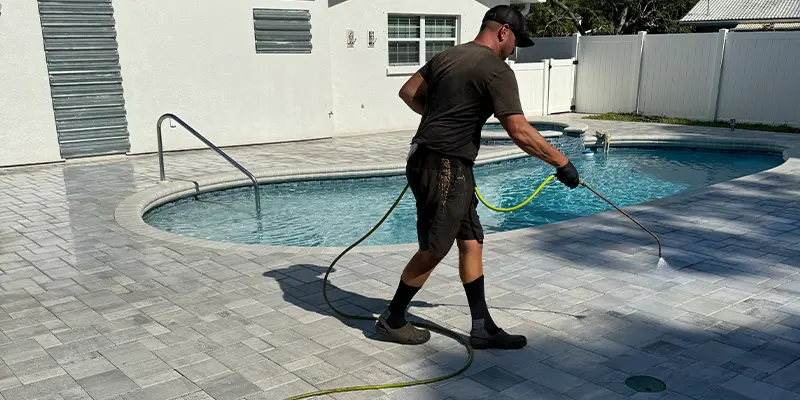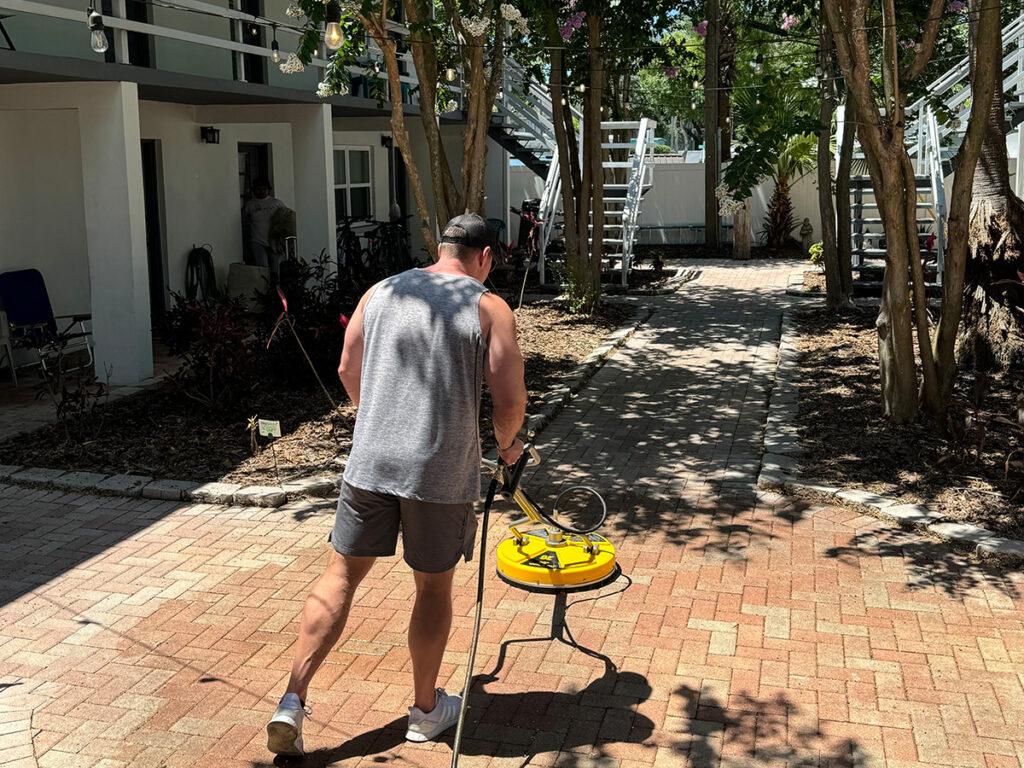FAQ
Call Today – 24/7
FREQUENTLY ASKED QUESTIONS
//
GENERAL QUESTIONS



Why should I seal my pavers or natural stone?
“This is a great question, and one we feel isn’t asked enough. Each type of exterior surface needs maintained and protected in its own unique way and for its own unique reasons. Too often, we see companies apply a one-size-fits all technique to all surfaces.
Concrete Pavers – Most paver driveways and paver pool decks that you’ll see in Florida are made from concrete. When these pavers are made, the manufacturer mixes concrete with color pigments to achieve the color of the paver. Once these pavers are installed, they are exposed to the sun’s UV rays, acid in rain, impact from rain, salt in the air and in salt water pools, traffic, etc. The sun’s rays will deteriorate the color pigment in the paver causing them to slowly loose their color. The other elements cause a breakdown of the finer cement material on the surface of the paver exposing the rocks in the concrete mix. These rocks don’t accept the color pigment during the manufacturing process, so they will be their natural color and not the color of the paver.
These are concrete pavers. Notice the line down the middle. The pavers on the right appear more worn than the pavers on the left. That’s because the pavers on the left are under a roof overhang that blocks out the sun and rain. The pavers on the right get exposure to the sun and rain. Had these pavers been sealed, the pavers on the right would look like the pavers on the left.
Travertine, Limestone and Natural Stone Pavers – Unlike concrete pavers, travertine and limestone pavers are natural. No color pigment has been used to achieve their color, so you will never have to worry about color loss from natural stone. However, rain and salt in the air and in salt water pools will deteriorate travertine and limestone pavers over time. By sealing the travertine, this will help prevent this from happening. Properly protected, these types of materials will outlive the home. Unprotected when exposed to these elements, expect them to last as long as man made products.
Equally as important as sealing travertine, limestone and other natural stones is keeping the sand material locked in the joints or gaps between each stone. This is assuming these stones were sand set and not mortar set. On sand set natural stone installations, the sand must be installed in the joints for several reasons.
A few are:
1. To create a cushion from one stone to the next to help minimize chipping
2. Achieve friction between each stone so that the stones move up and down as one and not independent of each other causing unevenness,
3. The sand in the joints prevents heavy rains and cleaning from washing out and eroding the sand bed beneath the pavers. This is the leading cause to unevenness between one stone to the next. We see it often where a client has a travertine pool deck full of uneven stones. The thing they all have in common is, the joints are empty from frequent pressure washing or neglect.
4. When the joints are empty, they are prone to fill up with airborne organic material that blows across the stones and begins to collect. This organic material turns the gaps between your stones in to a mold and vegetation breading ground.
To combat all of this, our process on natural stone includes washing out the organic build up and sand from the joints and replacing it with our Polymeric Sand Grout which will lock itself in the joints preventing erosion of both the sand joint and the sand bed beneath the pavers.
Chicago Brick – Although Chicago Brick and Clay Pavers are man made, their color is achieved in a completely different manor. No pigments are used. Instead, when these brick are made the color is determined by the clay used to make the paver and by how hot and how long the pavers are cooked in the kiln. These types of pavers will not loose their colors. However, similar to natural stone, they can deteriorate from salt in the air and in salt water pools. Therefore, they need to be protected when installed when these elements exist. Brick are very porous, so they can often store a lot of moisture. This constant damp environment can lead to major black mold growth. Sealing pavers with a water repellant type sealer will stop the penetration of water in to the paver which will dramatically reduce these issues.
In addition to sealing, we strongly suggest keeping the joints of Chicago Brick filled with sand. Due to the inconsistency in size of the Chicago Brick, there are almost always lager gaps/joints between each stone than other types of pavers. These joints, if not filled with sand, allow the pavers to shift and move. Overtime, this can lead to major issues. To combat this, our process on Chicago Brick includes washing out the organic build up and sand from the joints and replacing it with our Polymeric Sand Grout. This polymeric sand will lock itself in the joints preventing erosion of both the sand joint and the sand bed beneath the pavers which will help prevent the pavers from shifting.
Quick Service
7 Days a Week
Receive prompt assistance available 7 days a week. Your urgent needs are our top priority.